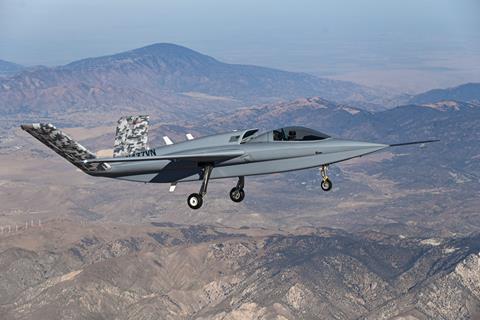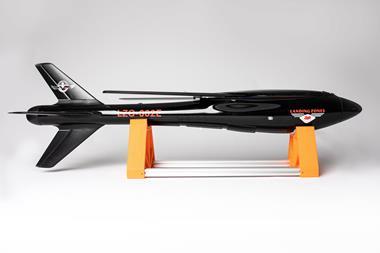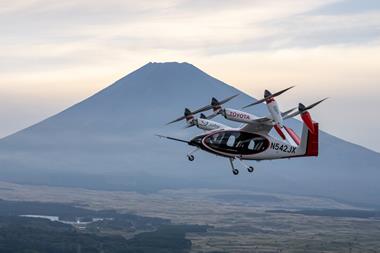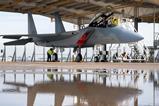US defence manufacturer Northrop Grumman has released video showing first flight of a low-cost jet developed to demonstrate new manufacturing techniques.
Assembled and flown by Northrop subsidiary Scaled Composites, the Model 437 Vanguard logged its maiden sortie on 29 August over California’s high desert. A 5 September post on Northrop’s YouTube channel shows the craft’s launch from the Mojave Air & Space Port.
The jet is powered by a single Pratt & Whitney Canada PW535 business-jet turbofan and features V-tail vertical stabilisers and an air intake behind the one-person cockpit. It boasts a wingspan of 12.5m (41ft) and total length of 12.5m.
By way of comparison, Lockheed Martin’s F-16C/D fighter has a wingspan of 9.8m and a length of 14.8m, according to the US Air Force (USAF).
Derived from Scaled Composites’ experimental Model 401, the Model 437 is intended to help Northrop evaluate new aircraft concepts, including so-called “attritable” aircraft, a class envisioned as being produced in sufficient numbers and at sufficiently low cost to be effectively expendable. The Model 437 was developed under a collaboration between Northrop and Scaled Composites, with Northrop designing and producing the Model 437’s removable wings.
The demonstration project is part of an industrial modernisation effort Northrop calls Digital Pathfinder, which aims to replace legacy design techniques with methods that are faster, cheaper and necessitate less engineering rework.
“This project demonstrates how high-fidelity models within our digital ecosystem serve as a single source of truth to streamline testing and certification on future aircraft, significantly saving cost and time for our customer,” says Colin Miller, vice-president of engineering at Northrop Grumman Aeronautics Systems.
The Model 437’s unique design features include a titanium structural bracket produced using an additive manufacturing technique called plasma-arc energy deposition.
The use of that process to form an all-metal titanium component “is believed to be a first in the defence industry”, according to Northrop.

The company also took unspecified steps to reduce the amount of hand tooling work required during assembly and to improve first-time quality of aircraft components.
Digital modelling and simulations were used to minimise required ground and flight testing, shortening the aircraft’s clean-sheet development timeline through aerodynamic and structural analysis, fuselage and empennage fabrication, aircraft assembly and systems integration.
“These models show the potential to significantly reduce the workload required to determine airworthiness, offering further cost and schedule savings opportunities,” Northrop says.
Notably, the digitally integrated approach to design and manufacturing reduced engineering rework and redesign to less than 1%, compared to the 15-20% logged using traditional industrial methods, it adds.
While the Model 437 is not meant for active military service, the demonstrator is being designed as a potential basis for future defence offerings.
Scalable Composites says the Model 437 will boast a range of 3,000nm (5,550km), 6h of flight endurance and a 907kg (2,000lb) payload, with two internal weapons bays sized to accommodate two Raytheon AIM-120 advanced medium-range air-to-air missiles.
The USAF is in early stages of developing so-called Collaborative Combat Aircraft (CCA) – small, low-cost uncrewed jets capable of supporting conventional fighters with a range of capabilities.
Northrop was selected in January as an initial contender for the first round of CCA development. However, the company was ultimately beat out by uncrewed aircraft maker General Atomics Aeronautical Systems and autonomy start-up Anduril.
The Pentagon says it plans to issue subsequent rounds of CCA contracts as the capability advances.

























































